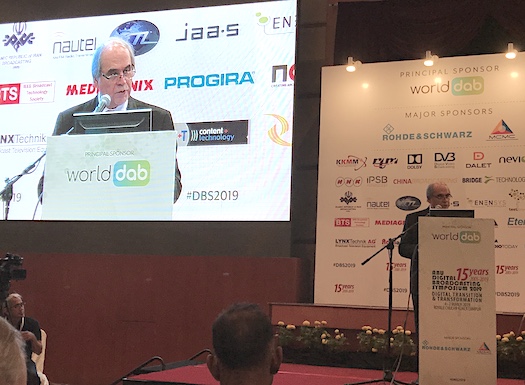Opening the first day of the Digital Broadcasting Symposium in Kuala Lumpur this morning, ABU Director General Javad Mottaghi congratulated ABU members and his team for achieving 15 years of industry leadership with this conference.
“The 15th edition of DBS presents a unique opportunity to network and exchange expertise,” said Mottaghi.
Topics to be covered in the three day symposium will include Cloud Computing, Artificial Intelligence and New Media Platforms.
“There are many new opportunities for broadcasters… The connected environment also offers new challenges, such as cyber attacks.
“Artificial intelligence, new methods of audience research and personalisation, in combination, with big data is providing new opportunities for broadcasters to adjust their business models. We need to work together to share the expertise in these areas,” said Mottaghi.
Speaking on behalf of major sponsor WorldDAB, Commercial Radio Australia’s Joan Warner made the point that in the digital age, audiences expect more from broadcasters.
“We can use digital opportunities to deliver to the changing needs of the audience. Audiences want our content, advertisers like our ability to reach customers and governments want our support in delivering services.
“There are multiple ways of accessing content, broadcast radio is the backbone of that,” said Warner
Warner listed some key point that broadcasters need to think about as technology continues to progress:
- How easy is it for people to go seamlessly to our content on many platforms and devices?
- Voice experiences for listeners must be seamless. Industry needs to work with manufacturers to ensure that this can happen.
- Radio faces a challenge in the car as screens go supersized. World DAB has updated its User Experience Guidelines to ensure that there is rich media available for the screens.
Another trend is voice to control. Warner explained the experience of the Australian radio industry. Initially stations were available to Alexa and Google smart speakers via TuneIn, but this was not satisfactory. To deliver a better user experience Australia’s commercial and national broadcasters joined together to deliver 318 stations in one RadioApp, then developed a ‘skill’ so that Alexa and Google could deliver these radio stations streams from the RadioApp instead of TuneIn or some other streaming aggregator.
“RadioApp is now the default source for Australian radio on Amazon Alexa, because we solved a problem for them.
“There are 315 stations, but there are 3465 ways to ask for those stations. That’s the challenge around voice, we expect Alexa to know what we mean when we ask to play a station. The ‘skill’ we created has solved this problem,” said Warner.
As well as improving the customer experience for listeners, broadcasters must also improve the opportunities for advertisers, such as more content, more targeted marketing opportunities, making the buying experience easier, and providing enhanced audience measurement.
“2019 is shaping up to be another year of digital transformation,” concluded Warner.
Lindsay Cornell from the World DAB technical committee discussed key points to think about when considering digital radio switchover.
When people talk about switchover they usually mean tv, but in many countries, digital radio switchover is now being discussed.
Some of the important things to consider when thinking about switchover include:
- common standards
- frequencies being used
- receiver displays
- language fonts.
These issues were considered by WorldDAB and standards have been developed.
Devices that conform to the standards are given a ‘tick mark’ that ensures that consumers know they will work across many countries and will deliver the maximum quality available.

